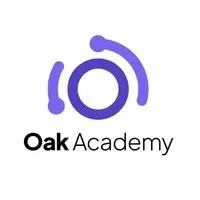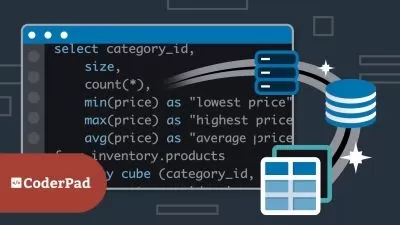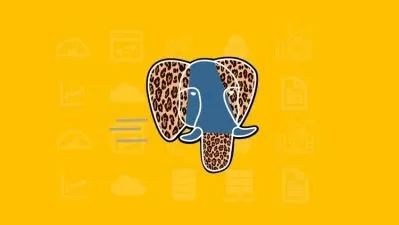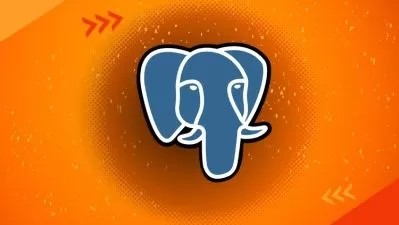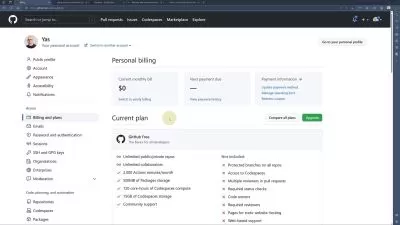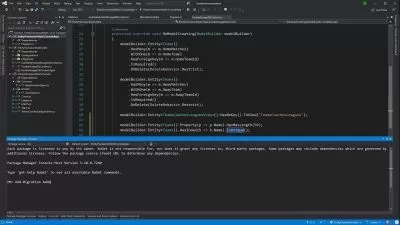PostgreSQL | Learn T-SQL Using PostgreSQL with Real Examples
Oak Academy
5:12:14
Description
PostgreSQL - Learn Relational Database and PostgreSQL Database Administration with PostgreSQL and become Postgres master
What You'll Learn?
- Basic Relational Database Concepts
- Normalization
- PostgreSQL Basics
- SQL Basics
- Database Tools to Build Your Own Data Architecture
- Privileges
- Partitioning
- Inheritance
- Row Security Policies
- Some Trip And Trick That Make the life easier for you when using postgresql
- The Groupby and having clauses
- How To Construct Your Own Relational Data Set
- Network Address Types
Who is this for?
What You Need to Know?
More details
DescriptionWelcome to "PostgreSQL | Learn T-SQL Using PostgreSQL with Real Examples" course.
PostgreSQL - Learn Relational Database and PostgreSQL Database Administration with PostgreSQL and become Postgres master
Postgresql is a powerful, open source object-relational database system that uses and extends the SQL language combined with many features that safely store and scale the most complicated data workloads. The origins of Postgresql date back to 1986 as part of the POSTGRES project at the University of California at Berkeley and has more than 30 years of active development on the core platform.
PostgreSQL, like other relational and object-oriented databases, let non-IT specialists query databases. PostgreSQL is open-source, fault-tolerant, and supports location-based services.
Known for reliability, scalability, and robustness, PostgreSQL is widely used by organizations of all sizes for managing large and complex databases. This makes it well-suited for high-performance and mission-critical applications such as data warehousing, analytics, geospatial applications, and web services.
PostgreSQL has been adopted by a variety of industries as the database management system of choice. PostgreSQL is great for handling scientific data, as well as finance and manufacturing information. Take our course and become a PostgreSQL power user. postgresql, postgres, postgresql database administration, sql, sql masterclass, data analytics, sql for data analytics, sql masterclass: sql for data analytics, advanced sql
Postgresql has earned a strong reputation for its proven architecture, reliability, data integrity, robust feature set, extensibility and the dedication of the open source community behind the software to consistently deliver performant and innovative solutions. Postgresql runs on all major operating systems (Linux, Macos, Windows, BSD, Solaris), has been ACID compliant since 2001, and has powerful add-ons such as the popular POSTGIS geospatial database extender.
PostrgeSQL comes with many features aimed to help developers build applications, administrators to protect data integrity and build fault-tolerant environments, and help you manage your data no matter how big or small the dataset. In addition to being free and open source, PostgreSQL is highly extensible. For example, you can define your own data types, build out custom functions, even write code from different programming languages without recompiling your database.
PostgreSQL supports many of features required by the SQL standard, though sometimes with slightly differing syntax or function. As the version 14 release in September 2021, PostgreSQL conforms to at least 170 of the 179 mandatory features for SQL:2016 Core conformance. As I know, no relational database meets full conformance with this standard as of now.
PostgreSQL has client server architecture. A main server process runs on postgresql machine. This process is responsible for starting other background processes and accepting new client connections. You can connect postgresql database from local machine or remote machines. When you connect postgresql from localhost, then unix socket file is used as communication protocol. If you connect postgresql from remote, the communication goes through TCP/IP.
This course provides valuable knowledge on using PostgreSQL database.
You will learn at the end of this course about :
Basic Relational Database Concepts
Normalization
PostgreSQL Basics
Database Tools to Build Your Own Data Architecture
Privileges
Partitioning
Inheritance
Row Security Policies
Simple Structure Of PostgreSQL
How To Construct Your Own Relational Data Set
SQL Basics
Using SQL Objects Effectively
Details Of SQL Language.
Join Types
Subqueries
Combining Queries
The Groupby and having clauses
Grouping Sets Cube And Rollup.
Some Trip And Trick That Make the life easier for you when using postgresql
Also you will learn all data types like
Recursive With Queries
Numeric Types
Monetary Types
Character Types
Binary Data Types
Datetime types
Boolean type
Enumerated types
Network Address Types
Bit string types
UUID types
XML type
JSON type
Arrays in Postgre SQL.
The course includes fertile examples that make your learning process easier. We also try to keep content compact and fluent.
With my up-to-date course, you will also have the chance to keep yourself updated. I am also happy to say that I will always be available to support your learning and answer your questions.
What is PostgreSQL and why it is used?
It is a highly stable database management system, backed by more than 20 years of community development which has contributed to its high levels of resilience, integrity, and correctness. PostgreSQL is used as the primary data store or data warehouse for many web, mobile, geospatial, and analytics applications.
Why PostgreSQL is more popular?
PostgreSQL is chosen by companies because it offers data types that MySQL does not, as well as many other features that are not offered in MySQL. Generally, however, MySQL is typically recommended for web-based/online or mapping functions, whereas PostgreSQL is recommended for large analytical processes.
What is difference between SQL and PostgreSQL?
PostgreSQL supports Python, PHP, Perl, Tcl, Net, C, C++, Delphi, Java, JavaScript (Node. js), and more. SQL Server is more limited, offering support for Java, JavaScript (Node. js), C#, C++, PHP, Python, and Ruby.
What is PostgreSQL best for?
Known for reliability, scalability, and robustness, PostgreSQL is widely used by organizations of all sizes for managing large and complex databases. This makes it well-suited for high-performance and mission-critical applications such as data warehousing, analytics, geospatial applications, and web services.
Is PostgreSQL enough to get a job?
The high estimated earnings are one of its many perks. The biggest advantage is you can build a really good career by learning even just PostgreSQL. A little hard work and ambition can lead you to the top and enable you to develop steadily. And as a result, you build a better life!
Is PostgreSQL a programming language?
PostgreSQL (pronounced post-gress-Q-L) offers the full functionality of Structured Query Language (SQL) — a standard programming language for database management — and many other feature enhancements and extensions.
Why learn PostgreSQL?
It is great for large datasets. It's less prone to data corruption. It's still the most advanced open-source RDBMS in the world. And it's an excellent choice for those who are new to SQL.
Is PostgreSQL free?
A: PostgreSQL is released under the OSI-approved PostgreSQL Licence. There is no fee, even for use in commercial software products. Please see the PostgreSQL Licence.
Do companies use PostgreSQL?
Around the world in 2023, over 58509 companies have started using PostgreSQL as relational-databases tool. Companies using PostgreSQL for relational-databases are majorly from United States with 22627 customers. 33.26% of PostgreSQL customers are from the United States.
Why do people prefer PostgreSQL?
PostgreSQL has advanced features.
PostgreSQL supports a huge number of features, many of which aren't available on other database systems. Just some examples of these include: Indexes that support different collations, types, access methods, and operators.
Why would you want to take this course?
Our answer is simple: The quality of teaching.
When you enroll, you will feel the OAK Academy's seasoned instructors' expertise.
Fresh Content
It’s no secret how technology is advancing at a rapid rate and it’s crucial to stay on top of the latest knowledge. With this course, you will always have a chance to follow the latest data science trends.
Video and Audio Production Quality
All our content is created/produced as high-quality video/audio to provide you the best learning experience.
You will be,
Seeing clearly
Hearing clearly
Moving through the course without distractions
You'll also get:
Lifetime Access to The Course
Fast & Friendly Support in the Q&A section
Udemy Certificate of Completion Ready for Download
Dive in now into the "PostgreSQL | Learn T-SQL Using PostgreSQL with Real Examples" course.
PostgreSQL - Learn Relational Database and PostgreSQL Database Administration with PostgreSQL and become Postgres master
We offer full support, answering any questions.
See you in the course!
Who this course is for:
- Users That Want to Learn PostgreSQL database from scratch
- Database Admins in other databases and transform their profession to postgres
- From Beginner To Mediocre Postgres Database Admins That Want to deepening their skills
- Software Developers That want to be aware of whats going on at the database level or which database object they can benefit
Welcome to "PostgreSQL | Learn T-SQL Using PostgreSQL with Real Examples" course.
PostgreSQL - Learn Relational Database and PostgreSQL Database Administration with PostgreSQL and become Postgres master
Postgresql is a powerful, open source object-relational database system that uses and extends the SQL language combined with many features that safely store and scale the most complicated data workloads. The origins of Postgresql date back to 1986 as part of the POSTGRES project at the University of California at Berkeley and has more than 30 years of active development on the core platform.
PostgreSQL, like other relational and object-oriented databases, let non-IT specialists query databases. PostgreSQL is open-source, fault-tolerant, and supports location-based services.
Known for reliability, scalability, and robustness, PostgreSQL is widely used by organizations of all sizes for managing large and complex databases. This makes it well-suited for high-performance and mission-critical applications such as data warehousing, analytics, geospatial applications, and web services.
PostgreSQL has been adopted by a variety of industries as the database management system of choice. PostgreSQL is great for handling scientific data, as well as finance and manufacturing information. Take our course and become a PostgreSQL power user. postgresql, postgres, postgresql database administration, sql, sql masterclass, data analytics, sql for data analytics, sql masterclass: sql for data analytics, advanced sql
Postgresql has earned a strong reputation for its proven architecture, reliability, data integrity, robust feature set, extensibility and the dedication of the open source community behind the software to consistently deliver performant and innovative solutions. Postgresql runs on all major operating systems (Linux, Macos, Windows, BSD, Solaris), has been ACID compliant since 2001, and has powerful add-ons such as the popular POSTGIS geospatial database extender.
PostrgeSQL comes with many features aimed to help developers build applications, administrators to protect data integrity and build fault-tolerant environments, and help you manage your data no matter how big or small the dataset. In addition to being free and open source, PostgreSQL is highly extensible. For example, you can define your own data types, build out custom functions, even write code from different programming languages without recompiling your database.
PostgreSQL supports many of features required by the SQL standard, though sometimes with slightly differing syntax or function. As the version 14 release in September 2021, PostgreSQL conforms to at least 170 of the 179 mandatory features for SQL:2016 Core conformance. As I know, no relational database meets full conformance with this standard as of now.
PostgreSQL has client server architecture. A main server process runs on postgresql machine. This process is responsible for starting other background processes and accepting new client connections. You can connect postgresql database from local machine or remote machines. When you connect postgresql from localhost, then unix socket file is used as communication protocol. If you connect postgresql from remote, the communication goes through TCP/IP.
This course provides valuable knowledge on using PostgreSQL database.
You will learn at the end of this course about :
Basic Relational Database Concepts
Normalization
PostgreSQL Basics
Database Tools to Build Your Own Data Architecture
Privileges
Partitioning
Inheritance
Row Security Policies
Simple Structure Of PostgreSQL
How To Construct Your Own Relational Data Set
SQL Basics
Using SQL Objects Effectively
Details Of SQL Language.
Join Types
Subqueries
Combining Queries
The Groupby and having clauses
Grouping Sets Cube And Rollup.
Some Trip And Trick That Make the life easier for you when using postgresql
Also you will learn all data types like
Recursive With Queries
Numeric Types
Monetary Types
Character Types
Binary Data Types
Datetime types
Boolean type
Enumerated types
Network Address Types
Bit string types
UUID types
XML type
JSON type
Arrays in Postgre SQL.
The course includes fertile examples that make your learning process easier. We also try to keep content compact and fluent.
With my up-to-date course, you will also have the chance to keep yourself updated. I am also happy to say that I will always be available to support your learning and answer your questions.
What is PostgreSQL and why it is used?
It is a highly stable database management system, backed by more than 20 years of community development which has contributed to its high levels of resilience, integrity, and correctness. PostgreSQL is used as the primary data store or data warehouse for many web, mobile, geospatial, and analytics applications.
Why PostgreSQL is more popular?
PostgreSQL is chosen by companies because it offers data types that MySQL does not, as well as many other features that are not offered in MySQL. Generally, however, MySQL is typically recommended for web-based/online or mapping functions, whereas PostgreSQL is recommended for large analytical processes.
What is difference between SQL and PostgreSQL?
PostgreSQL supports Python, PHP, Perl, Tcl, Net, C, C++, Delphi, Java, JavaScript (Node. js), and more. SQL Server is more limited, offering support for Java, JavaScript (Node. js), C#, C++, PHP, Python, and Ruby.
What is PostgreSQL best for?
Known for reliability, scalability, and robustness, PostgreSQL is widely used by organizations of all sizes for managing large and complex databases. This makes it well-suited for high-performance and mission-critical applications such as data warehousing, analytics, geospatial applications, and web services.
Is PostgreSQL enough to get a job?
The high estimated earnings are one of its many perks. The biggest advantage is you can build a really good career by learning even just PostgreSQL. A little hard work and ambition can lead you to the top and enable you to develop steadily. And as a result, you build a better life!
Is PostgreSQL a programming language?
PostgreSQL (pronounced post-gress-Q-L) offers the full functionality of Structured Query Language (SQL) — a standard programming language for database management — and many other feature enhancements and extensions.
Why learn PostgreSQL?
It is great for large datasets. It's less prone to data corruption. It's still the most advanced open-source RDBMS in the world. And it's an excellent choice for those who are new to SQL.
Is PostgreSQL free?
A: PostgreSQL is released under the OSI-approved PostgreSQL Licence. There is no fee, even for use in commercial software products. Please see the PostgreSQL Licence.
Do companies use PostgreSQL?
Around the world in 2023, over 58509 companies have started using PostgreSQL as relational-databases tool. Companies using PostgreSQL for relational-databases are majorly from United States with 22627 customers. 33.26% of PostgreSQL customers are from the United States.
Why do people prefer PostgreSQL?
PostgreSQL has advanced features.
PostgreSQL supports a huge number of features, many of which aren't available on other database systems. Just some examples of these include: Indexes that support different collations, types, access methods, and operators.
Why would you want to take this course?
Our answer is simple: The quality of teaching.
When you enroll, you will feel the OAK Academy's seasoned instructors' expertise.
Fresh Content
It’s no secret how technology is advancing at a rapid rate and it’s crucial to stay on top of the latest knowledge. With this course, you will always have a chance to follow the latest data science trends.
Video and Audio Production Quality
All our content is created/produced as high-quality video/audio to provide you the best learning experience.
You will be,
Seeing clearly
Hearing clearly
Moving through the course without distractions
You'll also get:
Lifetime Access to The Course
Fast & Friendly Support in the Q&A section
Udemy Certificate of Completion Ready for Download
Dive in now into the "PostgreSQL | Learn T-SQL Using PostgreSQL with Real Examples" course.
PostgreSQL - Learn Relational Database and PostgreSQL Database Administration with PostgreSQL and become Postgres master
We offer full support, answering any questions.
See you in the course!
Who this course is for:
- Users That Want to Learn PostgreSQL database from scratch
- Database Admins in other databases and transform their profession to postgres
- From Beginner To Mediocre Postgres Database Admins That Want to deepening their skills
- Software Developers That want to be aware of whats going on at the database level or which database object they can benefit
User Reviews
Rating
Oak Academy
Instructor's Courses
Udemy
View courses Udemy- language english
- Training sessions 62
- duration 5:12:14
- Release Date 2023/07/31





